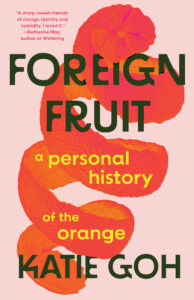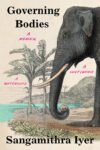
[Tin House; 2025]
“Drink an orange and you drink in everything the fruit has come to embody — health, sunshine, nostalgia, luxury, California — even if its juice is nothing but sugar and invention,” writes Katie Goh in her hybrid memoir Foreign Fruit: A Personal History of the Orange. On the surface level, this line decries contemporary myths of the orange in American culture. It is both a sentence-level distillation of the book as well as the driving impulse of Goh’s project. In a tone that is sharp, aware, and clear, Goh uses the orange to examine myths of nation making, landscape, and belonging that shape the contemporary world. In sections divided by place — marked by both the history of the orange as well as Goh’s personal histories — Goh tracks the orange across history and global geography. The orange, in Goh’s deft, sharp prose, becomes a way to unravel myths of self, nation, and belonging.
The morning after a white man murders five Asian women in Atlanta in 2021, Goh eats five oranges out of a blue and white porcelain bowl. Beginning from this image, Goh’s memoir tracks her own experiences of belonging and not belonging while growing up in Ireland with a Malaysian father and an Irish mother. Later in the book, Goh writes of this moment: “I had taken for granted the land I had rooted myself to—a land where we live amongst the unevenly distributed spoils of empire. But then something startles you out of complacency. Five oranges sitting in a blue and white imitation of porcelain did that for me.” The orange, as a symbol that pushes her beyond comfort, becomes the catalyzing force of her journey to consider her histories of place and belonging. While symbolic, the orange is, for Goh, an object rooted in the immediacy of the contemporary moment and the historical and political violences that shape her subjectivity. Goh writes at a different point in the book: “Five oranges sitting in a bowl became more than fruit to me the morning after an act of violence unraveled the terror that I had been struggling to articulate since I was a child—the terror of exile, of exposure, and of rejection; the terror of being a hybrid creation.” The orange, as a horticultural product of hybridization, offers Goh a mirror to understanding herself as a product of human immigration and crossbreeding. The fruit’s migrations westward reflect Goh’s own migrations, her relationship to Malaysia and China, and then to Ireland. Like Goh, the orange too lacks agency in its movement west, subject to migrations made by family members before she was born and when she was a child. Towards the end of the prologue, Goh writes:
The orange is a souvenir of history. Across time, its appearance has been a harbinger of God and doom, fortune and failure, pleasure and suffering. It is a fruit containing metaphors, dreams, mythologies, superstitions, parables, and histories, all held within its tough rind. So what happens, then, when the fruit is peeled and each segment—each moment of history, each meaning across time—is pulled apart?
This question becomes the driving force of the book: Goh undertakes an expedition across the world to track the orange. Goh begins with the central premise of the orange as something that carries history — the weight of time, place and memory. While the orange is a readily available everyday object of consumer culture, something available year-round and nearly everywhere in the world, Goh shows us how history overlooks how the orange represents and allows us to read larger histories of capitalism and imperialism. Alongside this misrepresented fruit, Goh hopes to excavate her personal history of place from where her ancestors lived in China and Malaysia to her upbringing in Ireland. The orange, which she investigates across time, allows her to understand an account of herself and how she has come to be geographically placed — it offers her a way to read herself against, within, and outside history.
Goh’s narrative begins with a history of the orange in the Himalayas alongside a visit she undertook to Kuala Lumpur in 2010 with her family. Through this parallel framing, Goh describes how the orange occupies a dual role in history and culture. It is a commodity that moves through the world along routes of trade, as well as an object that is represented, in language and in art and in ideas. A seventeen-year-old struggling to articulate a self still coming-of-age, Goh’s experience of belonging is already fraught at her moment of encounter with this landscape. As a mixed-race child in the north of Ireland, Goh learns to make herself invisible, to assimilate into dominant social structures. From Kuala Lumpur, already unfamiliar to Goh, the family travels to China, to the village her great-grandfather immigrated from. In this old landscape that is new to Goh, she reckons with questions of language and familial relationships to place as she thinks through how she might begin to engage with these places and histories that are hers and not. Goh writes about an old woman who is a distant relative by marriage, the oldest person in the village:
As I watched her, I wanted to ask if her life had been everything she had hoped for. Was she satisfied with her origins? Did she know who we were to her? I wanted to know if she felt lonely or content, and if her memories were failing her, and if the past was slipping away. But we had no common tongue, and my mouth remained closed.
In this moment, we see the underlying impulses of Goh’s project: an impossible desire to undo the assimilation of her childhood. Here, Goh demonstrates a generosity of perspective that drives Goh’s quest to understand the orange. In this moment, language is impossible, but through reflection and metaphor, Goh comes to realizes she might yet be able to understand the familial histories that make Goh who she is.
Later in the book, Goh moves from the roots of the orange to thinking about its migrations, the networks of mobility that enable its many movements across space. “In my mind,” Goh writes from the perspective of childhood, “the Silk Road was a path, like Oz’s yellow brick road, where a flow of purple silks, yellow spices, and green stones moved from east to west and back again.” Here we see how Goh is willing to return to the imaginative, dreamlike nature of childhood experience. Rather than dismiss an early understanding of the Silk Road, Goh instead utilizes it to examine how, while an object’s movement across the world might initially seem direct, clear, and easy, it is actually fraught, complicated and shaped by history. Throughout the book, Goh keeps up this balance of using the personal to understand history, remaining aware of how her experiences as a child shapes how she tells her braided story.
Throughout the book, Goh considers representations of the orange in art and life. Goh describes a moment where, in 2020, she attempted to sketch oranges, to paint a still life, and articulates what she considers her own inability to fully capture the orange in art. She writes: “Still life; dead art for dead nature. I had failed to see what was in front of me. Instead, I had created a work that was half imitation, half imagination, and I hadn’t even realized I was doing it.” Here, Goh grounds us in the material, bringing the affective experience of imagination to the tangibility of the orange. In her own experience, the orange, even here, is impossible, just like her own hybrid experience of race and identity. The orange cannot be represented, just as she too finds it impossible to see herself represented in the landscapes she grew up in.
Later in the book, Goh brings her reader to Holland, where she examines the relationship between class and empire in relation to the objects that migrate west with Dutch colonialism. Here, Goh considers the still life paintings of Dutch artists, in particular Willem Kalf, to think through how the use of the orange here might reveal new ways to read the role of produce in relationship to violence, to colonialism, to imperialism. Goh notes that “[a]rranged beside clocks and watches, rancid fruit is a reminder that we are all at the mercy of time. To its owner, the orange might be a trinket of newfound wealth from overseas, but Kalf is also offering a warning: nothing lasts forever.” Fruit is not only a reminder of the past, but also a representation of the present; it makes us aware of the vantage points we view history from.
California is where Goh finally leaves the orange, having tracked it as far west as she can. Here, Goh ends her story by highlighting the globalizing forces of the present moment, in the landscapes of the United States. Goh writes:
Like Eve’s apple and Persephone’s pomegranate, California’s oranges are as much myth as they are fruit. They tell a story of an Eden at the end of the Wild West, of a paradise of empty land waiting to be cultivated into a grove of ripe fruit by a new generation of Anglo Americans. But that myth holds a multitude of other stories: of indigenous genocide, of forgotten foreign hands, of land reshaped, of orange barons, of capitalism, of manifest destiny. Oranges created California, and Californian agriculture bolstered the US’s industrial growth.
This passage, from nearly the end of the book, is emblematic of how Goh’s project in this book subverts itself. Aware of the long history of ecological writing about oranges shaped by dominant cultural narratives, Goh’s project here, as she makes clear here, is also to push against that dominant strain of ecological writing. As a woman of color, Goh writes from the margins of ecological writing, and in doing so, brings the center of these ecological histories into focus: in writing from the peripheries, Goh’s engagement with the orange allows us to understand it as shaped by migration and colonialism, rather than a neutral object.
Through the orange, Goh’s personal history — of erasure, racial tension, complacency, and the ongoing violence of history — is read anew. In turn, Goh’s personal history allows the orange to be read in new ways: fruit becomes an object and artifact of history, shaping the currents of the world and the present moment. Documenting the orange across time and space, Foreign Fruit is a powerful meditation on the relationships between commodities and colonialism, place and produce, self and history.
Vika Mujumdar was born in New Jersey and raised in Pune, India. She holds an MA in Comparative Literature from UMass Amherst, where she is currently an MFA student in Fiction. Her work has appeared in the Cleveland Review of Books, the Chicago Review of Books, Girls on Tops READ ME, the Brooklyn Rail, and elsewhere. She edits Liminal Transit Review.
This post may contain affiliate links.






